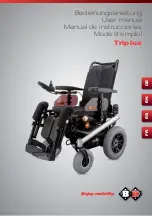
FREEDOM DESIGNS, INC
.
2241 Madera Rd. Simi Valley, CA. 93065 800-331-8551 Fax 888-582-1509
www.freedomdesigns.com
8
5. If you must reach or lean:
a.
Do not
lock the
Drive
wheels. This creates a tip point and makes a
fall or tip-over more likely.
b.
Do not
put pressure on the footrests.
Note:
Leaning forward puts pressure on the footrests and may cause the
chair to tip if you lean too far.
c. Move your chair as close as you can to the object you wish to
reach.
d.
Do not
try to pick up an object from the floor by reaching down
between your knees. You are less likely to tip if you reach to the
side of your chair.
e. Rotate the front casters until they are as far forward as possible.
This makes the chair more stable.
Note:
To do this: Move your chair past the object you want to reach,
then back up alongside it. Backing up will rotate the casters forward.
f. Firmly grasp an armrest with one hand. This will help to prevent a fall if the
chair
tips
.
If you fail to heed these warnings, damage to your chair, a fall, tip-over, or
loss of control may occur and cause severe injury to the rider or others.
Moving Backward
Use extra care when you move backward. Your chair is not stable when you propel
yourself rearward. You may lose control or tip over if one of the large
Drive
wheels
hits an object and stops rolling.
1. Propel your chair slowly and smoothly.
2. Stop often and check to be sure your path is clear.
If you fail to heed these warnings, damage to your chair, a fall, tip-over, or
loss of control may occur and cause severe injury to the rider or others.
Ramps, Slopes & Side Hills
Riding on a slope, which includes a ramp or side hill, will change the center of
balance of your chair. Your chair is less stable when it is at an angle. The rear
stabilizing wheel may not keep the chair from going over backward.
1.
Do not
use your chair on a slope steeper than 10%. (A 10% slope means: one
foot in elevation for every ten feet of slope length).
2.
Always
go as straight up and as straight down as you can. (do not “cut the
corner” on a slope or ramp).
3. Do
not
turn or change direction on a slope.
4.
Always
stay in the CENTER of the ramp. Make sure ramp is wide enough
that you are not at risk that a wheel may fall over the edge.
5,.
Do not
stop on a steep slope. If you stop, you may lose control of your chair.
6.
NEVER
use wheel locks to try to slow or stop your chair. This is likely to cause
your chair to veer out of control.
7. Beware of:
a. Wet or slippery surfaces.
b. A change in grade on a slope (or a lip, bump or depression). These may
cause a fall or tip-over.
c. A drop-off at the bottom of a slope. A drop-off of as small as 3/4”
can stop a front caster and cause the chair to tip forward.
8. To reduce the risk of a fall or tip-over:
a. Lean or press your body UPHILL. This will help adjust for a change
in the center of balance caused by the slope or side hill.
b. Keep pressure on the handgrips to control your speed on a down
W
A
R
N
I
N
G
!
Содержание CGX
Страница 2: ......











































